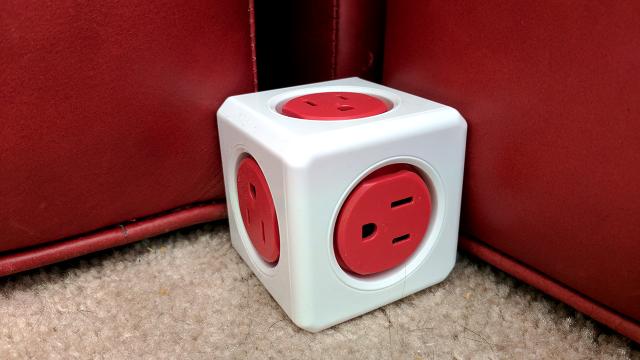Power strip are a large, awkward, and difficult if you need to use your gadgets while you charge them. The PowerCube ditches the bulk, and gives you plenty of outlets in a compact package, making it easy to plug in your devices while you use them around the house. Here’s why I love it, and why I think you will, too.
The PowerCube (between $28 and $40 at Officeworks) is a simple power strip with a little twist.
Instead of putting six power outlets on one long slab, the PowerCube puts five outlets on a small cube (with the cable coming out of the sixth side). Best of all, you can mount it on any of its five outlet faces with a handy sticky plate.
The PowerCube product line also has several adaptors and variations so you can add USB power outlets, stack multiple cubes, or add remote control switches. However, I’m focusing on the regular PowerCube, which I bought and immediately adored. Once you use it, it’s hard to go back to a standard power strip.
The PowerCube Is Compact and Fits Anywhere
The average power strip is around a 0.3m long or more, and can be pretty wide, adding unnecessary bulk. The PowerCube, by comparison, is 64mm² on all sides. It can fit nearly anywhere without getting in the way. This made it the perfect tool for me to use for charging gadgets on the couch, like my phone or laptop.
As you can see in the photo above, I ran the cable for the PowerCube behind my couch, leaving the cube sitting in the corner of our sectional couch. At first, I thought it would get in the way and guests would step on it. However, it’s so small that it’s never a problem. Feet never bump up against it, there’s no cord to trip over (aside from the ones running to your devices) and anyone who’s on the couch has an outlet that’s only half a metre away.
Even if you don’t have an outlet directly behind your couch, running a plug to the centre of the seating area is much more convenient than a side table. We’ve tried the same thing with a power strip, but it’s so big we frequently tripped over it.
That same low profile is handy in other situations, as well. On an entertainment unit, it’s small enough to fit on a shelf without blocking consoles or set top boxes, which puts it in a prime position to recharge remotes and console controllers. Under a desk, it sits in the corner without getting kicked around. Even without the additional features the PowerCube offers, the fact that it’s so small is a huge improvement over regular power strips.
The Included Plate Makes Mounting Super Simple
Check the back of your power strip and you’ll probably see a couple of screw holes. Whoever designed this thing expects that you’re going to get out a drill, a pair of screws, maybe make a photocopy of the bottom and put a hole in your wall or desk to mount it. That’s ridiculous. Instead, the PowerCube comes with a simple mounting plate.
The PowerCube’s plate has two adhesive pads on the back. Simply peel off the protective strips and stick the plate to the surface you want to hang your cube from. Then, you can slide the cube onto the plate and rotate it to lock it in place. The whole process takes a few seconds. If you really need the stability of screws in a wall, the plate has screw holes too, just in case.
The downside of this mounting method is that you lose one of your outlets in order to mount it. Unfortunately, that’s just how cubes work. Depending on the charging blocks you use, you may also bump into this situation if you put the cube on the floor. You can’t set the cube down on top of a flexible cord or you might damage it. The company has a number of different versions of the PowerCube you can configure to get the exact setup you need. It’s not perfect for every situation, but there are a lot of options.
The PowerCube’s Design Means Never Blocking Outlets With a Charging Brick Again
Some manufacturers just have no respect for the other devices that might need to use your power strip. If your device has a massive power block attached to the plug end, you end up blocking other outlets you may need to use on a regular power strip, especially if there’s already another giant block on the outlet at the end. The PowerCube’s design eliminates this problem.
Since each of the five outlets on the PowerCube are on their own face, there’s no overlap when you plug in giant blocks. Nothing gets in the way of anything else. In fact, if you plug in something with a large block, you can set that side on the floor. As we mentioned earlier, laying the cube on the floor can be a problem if it will damage a cable, but if a block is on the bottom, you have a safe surface to rest the cube on.
The PowerCube isn’t perfect for every single situation, but I was surprised to found out how well it fit in some of my setups. On my entertainment unit, it easily lets me plug in a lot of awkward cables that run in all directions. It’s perfect for letting guests charge their phone on the couch, and it’s a handy way to add a few extra outlets to my desk.

Comments